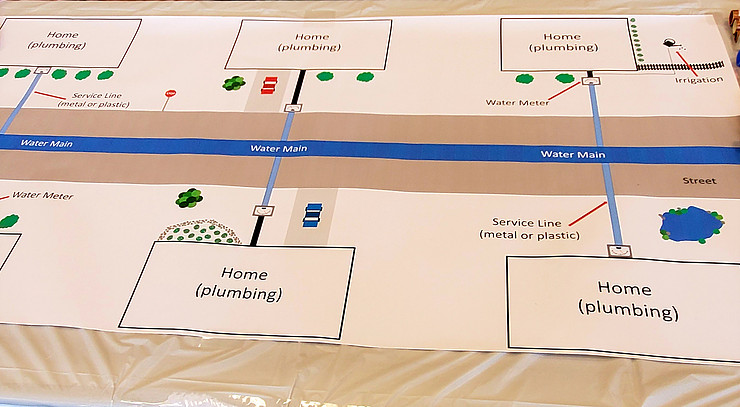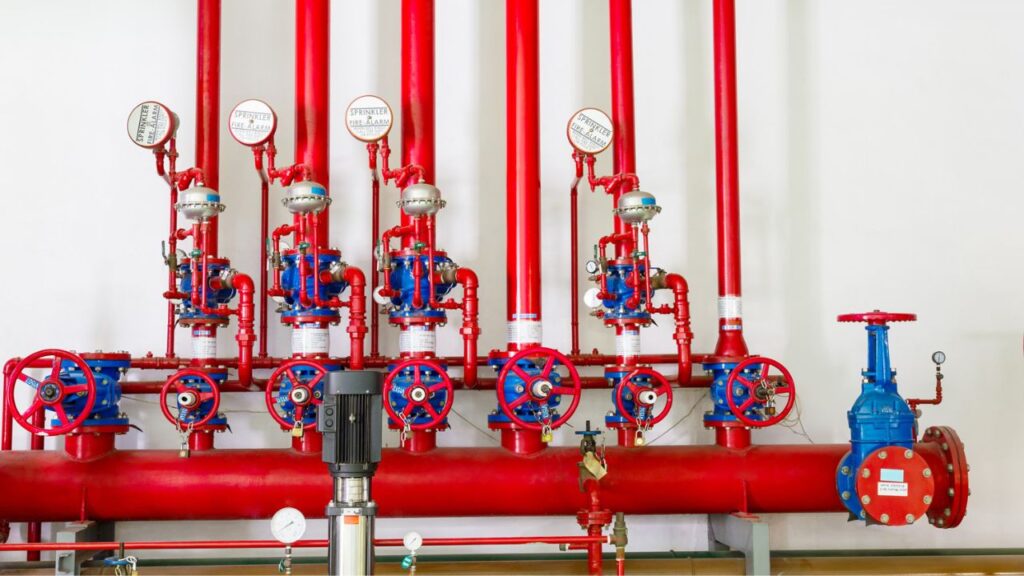The Core Elements of Your Home's Plumbing System
The Core Elements of Your Home's Plumbing System
Blog Article
Each person has got their own thinking about Exploring Your Homes Plumbing Anatomy.

Understanding exactly how your home's plumbing system works is crucial for each house owner. From providing clean water for drinking, food preparation, and showering to safely eliminating wastewater, a well-kept pipes system is crucial for your family's health and wellness and comfort. In this comprehensive overview, we'll discover the detailed network that composes your home's pipes and offer pointers on upkeep, upgrades, and handling typical issues.
Intro
Your home's pipes system is more than just a network of pipelines; it's a complicated system that ensures you have access to tidy water and efficient wastewater removal. Understanding its parts and just how they work together can help you prevent pricey fixings and make certain every little thing runs efficiently.
Standard Parts of a Pipes System
Pipelines and Tubing
At the heart of your plumbing system are the pipelines and tubing that lug water throughout your home. These can be constructed from numerous materials such as copper, PVC, or PEX, each with its advantages in regards to toughness and cost-effectiveness.
Fixtures: Sinks, Toilets, Showers, and so on.
Components like sinks, bathrooms, showers, and bath tubs are where water is used in your home. Comprehending exactly how these components link to the pipes system assists in diagnosing troubles and intending upgrades.
Valves and Shut-off Points
Valves control the circulation of water in your plumbing system. Shut-off shutoffs are essential throughout emergency situations or when you require to make repairs, enabling you to separate parts of the system without interrupting water circulation to the whole home.
Water System
Main Water Line
The main water line attaches your home to the local water or a private well. It's where water enters your home and is distributed to different components.
Water Meter and Stress Regulator
The water meter procedures your water usage, while a stress regulatory authority guarantees that water moves at a risk-free stress throughout your home's plumbing system, preventing damage to pipelines and components.
Cold Water vs. Warm water Lines
Comprehending the difference between cold water lines, which supply water directly from the primary, and warm water lines, which carry warmed water from the hot water heater, aids in repairing and preparing for upgrades.
Drainage System
Drain Pipes Water Lines and Traps
Drain pipes lug wastewater far from sinks, showers, and bathrooms to the sewer or septic tank. Traps protect against sewer gases from entering your home and likewise catch debris that can cause blockages.
Air flow Pipelines
Air flow pipes enable air right into the water drainage system, stopping suction that might slow water drainage and trigger catches to vacant. Correct air flow is essential for preserving the honesty of your plumbing system.
Relevance of Proper Drainage
Making sure correct water drainage protects against back-ups and water damage. On a regular basis cleansing drains pipes and keeping catches can protect against pricey repair work and extend the life of your plumbing system.
Water Heating Unit
Kinds Of Water Heaters
Water heaters can be tankless or conventional tank-style. Tankless heating systems warmth water as needed, while containers keep warmed water for instant usage.
How Water Heaters Attach to the Plumbing System
Recognizing exactly how water heaters connect to both the cold water supply and hot water distribution lines helps in diagnosing problems like not enough hot water or leaks.
Maintenance Tips for Water Heaters
On a regular basis flushing your water heater to remove debris, inspecting the temperature setups, and examining for leaks can expand its life-span and enhance energy performance.
Usual Pipes Problems
Leakages and Their Reasons
Leakages can take place as a result of maturing pipes, loose installations, or high water pressure. Attending to leaks without delay prevents water damages and mold and mildew development.
Clogs and Blockages
Clogs in drains and toilets are typically caused by purging non-flushable products or a buildup of oil and hair. Using drainpipe screens and being mindful of what decreases your drains can prevent obstructions.
Indications of Pipes Issues to Watch For
Low tide pressure, slow-moving drains, foul odors, or abnormally high water expenses are indicators of prospective pipes issues that must be addressed immediately.
Pipes Maintenance Tips
Routine Evaluations and Checks
Set up yearly plumbing examinations to catch concerns early. Look for indications of leaks, rust, or mineral buildup in faucets and showerheads.
Do It Yourself Maintenance Tasks
Basic jobs like cleansing faucet aerators, checking for commode leakages utilizing dye tablets, or protecting revealed pipelines in cold climates can stop significant pipes concerns.
When to Call a Professional Plumbing
Know when a pipes concern calls for professional competence. Trying intricate repairs without proper knowledge can result in even more damages and greater repair work expenses.
Upgrading Your Plumbing System
Reasons for Upgrading
Upgrading to water-efficient fixtures or replacing old pipes can improve water quality, minimize water bills, and increase the value of your home.
Modern Pipes Technologies and Their Advantages
Discover innovations like smart leakage detectors, water-saving toilets, and energy-efficient hot water heater that can save money and decrease environmental influence.
Cost Factors To Consider and ROI
Determine the in advance prices versus lasting financial savings when considering plumbing upgrades. Many upgrades pay for themselves via reduced utility costs and less fixings.
Ecological Influence and Preservation
Water-Saving Fixtures and Devices
Installing low-flow taps, showerheads, and commodes can substantially decrease water use without giving up efficiency.
Tips for Minimizing Water Use
Basic routines like taking care of leakages immediately, taking much shorter showers, and running full tons of laundry and dishes can conserve water and reduced your energy bills.
Eco-Friendly Pipes Options
Think about sustainable plumbing materials like bamboo for floor covering, which is durable and environment-friendly, or recycled glass for counter tops.
Emergency Readiness
Steps to Take Throughout a Plumbing Emergency situation
Know where your shut-off shutoffs are located and just how to shut off the water supply in case of a ruptured pipe or major leak.
Value of Having Emergency Situation Contacts Handy
Keep get in touch with info for local plumbing professionals or emergency situation services conveniently available for fast response during a plumbing situation.
Do It Yourself Emergency Situation Fixes (When Applicable).
Momentary fixes like using air duct tape to spot a dripping pipeline or putting a pail under a leaking faucet can minimize damages up until a professional plumbing professional shows up.
Final thought.
Comprehending the makeup of your home's plumbing system encourages you to maintain it efficiently, conserving time and money on fixings. By adhering to regular maintenance routines and remaining educated about modern-day pipes innovations, you can guarantee your plumbing system runs efficiently for several years to come.
HOW YOUR PLUMBING SYSTEM WORKS
Which Pipes Do What?
Blue lines = fresh water supply entering the building
Red lines = hot water supply entering the building
Grey lines = pipes carrying waste away from the building and venting pipes carrying gases away from the building (through the roof)
YOUR MAIN PLUMBING SYSTEMS
There are two main plumbing systems that support your home s basic plumbing needs one that brings clean water into your home, and one that sends dirty water away from your home. Connected to the toilet, bath, shower, and other faucets in your home, these two systems keep your water flowing in the right directions.
ACCESSING FRESH WATER
Fresh and clean water is brought into your home through the main water supply line . Filtered through one pipe, this water is pressured to flow into the various fixtures in your home at any given time.
This water can be sourced from a well located on your property, a pond or river (mostly cottages), or, as in most cases, from the city s municipal water treatment centre. However, it is important to note that water that is untreated, such as the water siphoned from ponds or rivers, may not be safe to drink. Personal water supplies always need to be treated for hardness and contaminants before consumed.
MUNICIPAL WATER SUPPLIES
Improve taste and odour
Remove sediment
Eliminate hardness
Reduce chlorine
COLD WATER SUPPLY VS. HOT WATER SUPPLY
Cold water flows into your home or building through the service line, which then distributes hot or cold water to your fixtures. This line is most commonly run through a central column that runs floor to floor. Hot water runs in short and straight pipes as the longer the pipeline, the more heat that will be lost in the transfer. Having shorter pipes also allows residents to access hot water more quickly.
WASTE WATER SYSTEM
Your wastewater system is divided into two parts pipes that send wastewater away from your home and venting pipes that send sewer gas away from your home. Sewage water travels through pipes that flush the water and waste towards local sewers that are operated and managed by your city or town. Most sewer systems rely on gravity to move the wastewater to where it needs to go.
The further away from your toilet or sink, the larger wastewater pipes become. This allows for waste to be disposed of from various parts of your home or business at once without pipe blockages. The angle and flow of these pipes are also essential for keeping your waste pipes clear of build up.
https://harrisplumbing.ca/how-your-home-plumbing-system-works/

HOW YOUR PLUMBING SYSTEM WORKS
Which Pipes Do What?
YOUR MAIN PLUMBING SYSTEMS
There are two main plumbing systems that support your home s basic plumbing needs one that brings clean water into your home, and one that sends dirty water away from your home. Connected to the toilet, bath, shower, and other faucets in your home, these two systems keep your water flowing in the right directions.
ACCESSING FRESH WATER
Fresh and clean water is brought into your home through the main water supply line . Filtered through one pipe, this water is pressured to flow into the various fixtures in your home at any given time.
This water can be sourced from a well located on your property, a pond or river (mostly cottages), or, as in most cases, from the city s municipal water treatment centre. However, it is important to note that water that is untreated, such as the water siphoned from ponds or rivers, may not be safe to drink. Personal water supplies always need to be treated for hardness and contaminants before consumed.
MUNICIPAL WATER SUPPLIES
COLD WATER SUPPLY VS. HOT WATER SUPPLY
Cold water flows into your home or building through the service line, which then distributes hot or cold water to your fixtures. This line is most commonly run through a central column that runs floor to floor. Hot water runs in short and straight pipes as the longer the pipeline, the more heat that will be lost in the transfer. Having shorter pipes also allows residents to access hot water more quickly.
WASTE WATER SYSTEM
Your wastewater system is divided into two parts pipes that send wastewater away from your home and venting pipes that send sewer gas away from your home. Sewage water travels through pipes that flush the water and waste towards local sewers that are operated and managed by your city or town. Most sewer systems rely on gravity to move the wastewater to where it needs to go.
The further away from your toilet or sink, the larger wastewater pipes become. This allows for waste to be disposed of from various parts of your home or business at once without pipe blockages. The angle and flow of these pipes are also essential for keeping your waste pipes clear of build up.
https://harrisplumbing.ca/how-your-home-plumbing-system-works/
As a reader about Plumbing Installation 101: All You Need to Know, I think sharing that blog post was important. Those who liked our blog entry please consider to pass it around. Many thanks for taking the time to read it.
Call Today Report this page